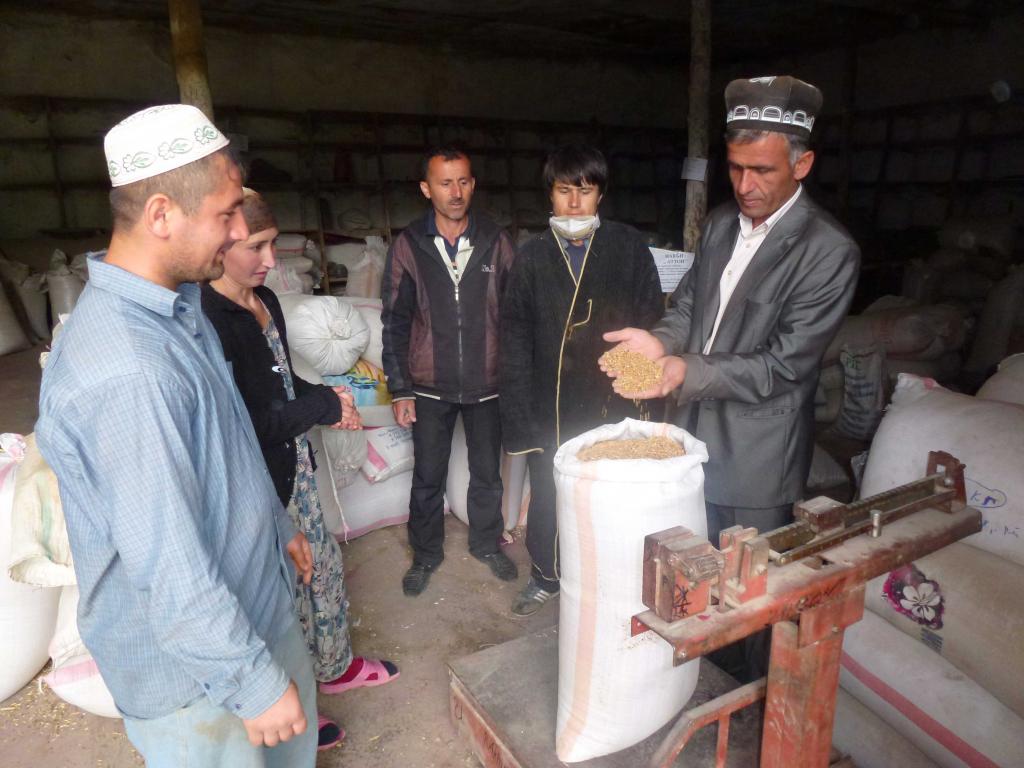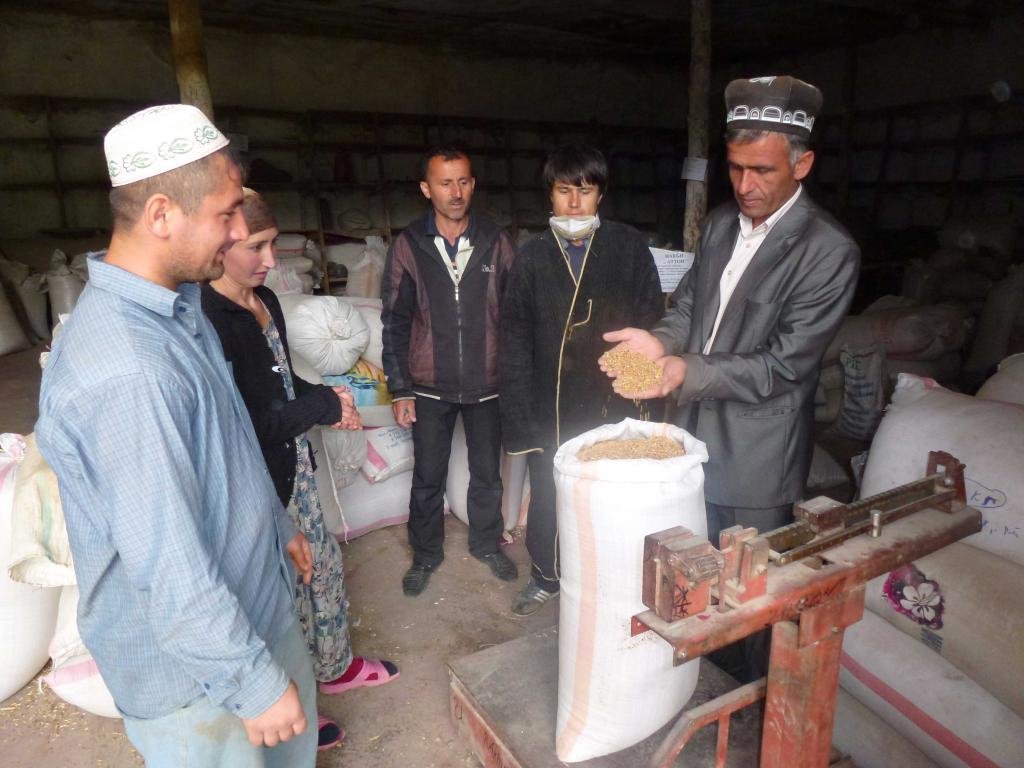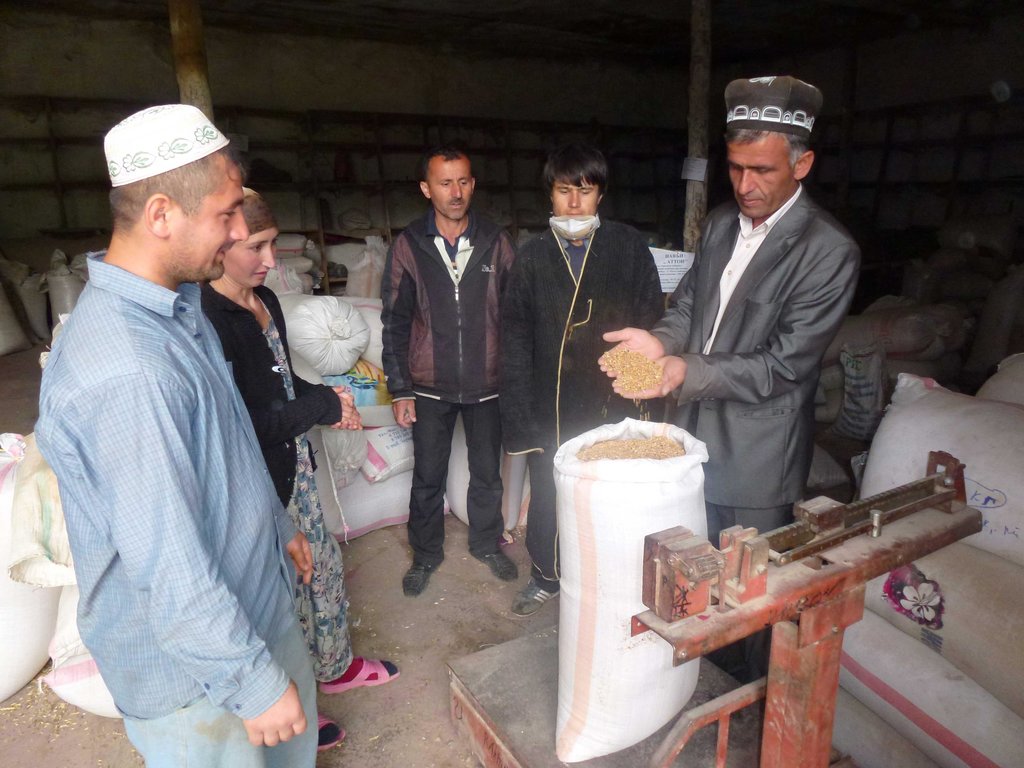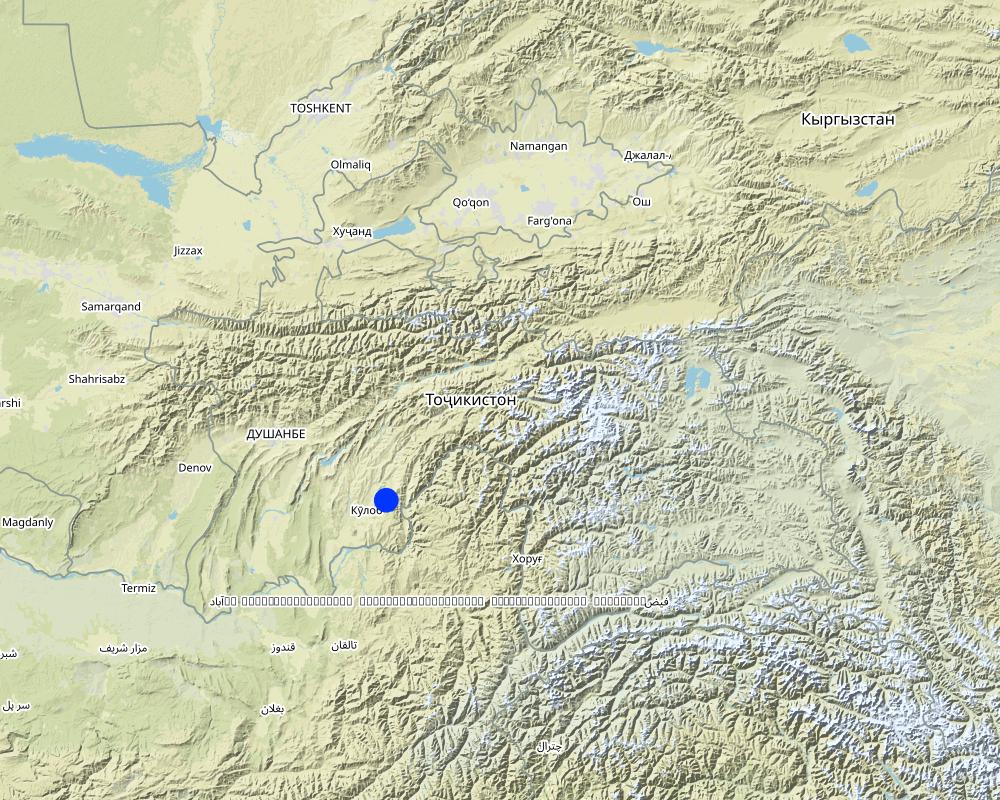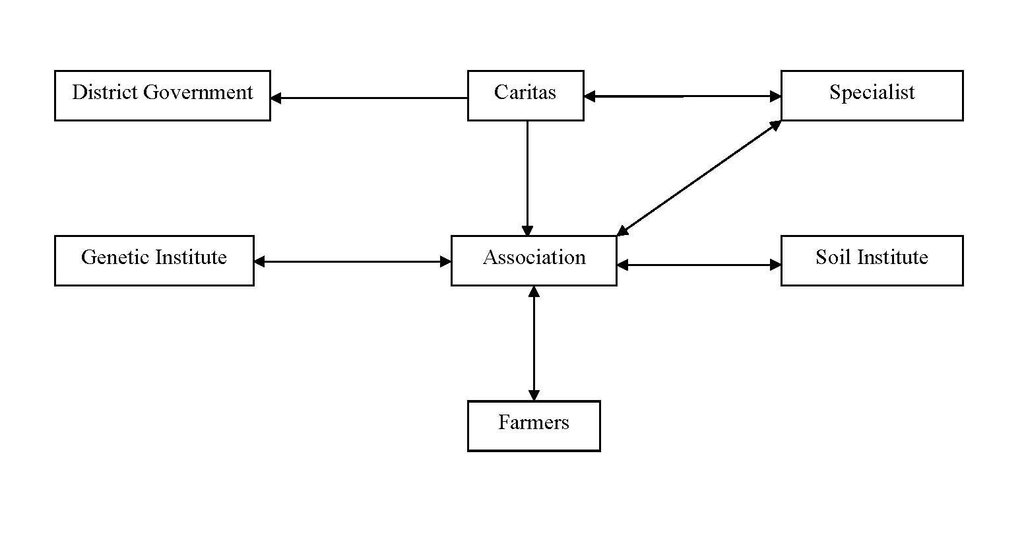District Wheat Seed Association [Tajikistan]
- Creation:
- Update:
- Compiler: Sa'dy Odinashoev
- Editor: –
- Reviewers: David Streiff, Alexandra Gavilano, Joana Eichenberger
Асотсиатсияи тухмипарвари гандум дар сатхи нохия
approaches_2440 - Tajikistan
View sections
Expand all Collapse all1. General information
1.2 Contact details of resource persons and institutions involved in the assessment and documentation of the Approach
SLM specialist:
Name of project which facilitated the documentation/ evaluation of the Approach (if relevant)
Pilot Program for Climate Resilience, Tajikistan (WB / PPCR)Name of the institution(s) which facilitated the documentation/ evaluation of the Approach (if relevant)
NCCR North-South (NCCR North-South) - Kyrgyzstan1.3 Conditions regarding the use of data documented through WOCAT
When were the data compiled (in the field)?
10/03/2010
The compiler and key resource person(s) accept the conditions regarding the use of data documented through WOCAT:
Yes
2. Description of the SLM Approach
2.1 Short description of the Approach
The Seed Association was established with the aims of improving the living conditions, food security, land management and crop rotation systems in irrigated and rain fed areas. The Seed association in Muminabad is registered at a district level and coordinates the activities of the farmers and members.
2.2 Detailed description of the Approach
Detailed description of the Approach:
Aims / objectives: The aim of this approach is to provide a long term wheat seed bank to improve food security in the district of Muminabad, Tajikistan. Previously, there was a lack of readily available good quality seed that was appropriate to the soil, and climatic conditions of the area. The aim of the approach was to provide cost effective, appropriate wheat seeds to farmers with more than 5h.a. of land. The farmers receive training and onsite support during the cultivation period, and in return have to adopt a crop rotation system, and give back to the association 150% of the originally received seed stock. The association continues to cultivate, and test, high quality seeds on its own land for distribution, and for selling at the local market to generate revenue to cover its operational costs.
Methods: The Association's members have to stick to a set of pre-determined conditions in order to join, and so operations can be controlled. The members must implement changes in agricultural practices, to support the work of the association. In return the members receive high quality tested seed, training and a support network.
Stages of implementation: The initial set up of the wheat association was provided by INGO (Caritas Switzerland) who provided the initial funding and support, which was supplemented by the provision of a 150h.a of arable land by the government. The initial five members of the association were provided with training in organisational set up and business development, they employed the services of an agronomist to help acquire appropriate seeds and develop a seed bank on the arable land. The association registered as a legal entity, and the INGO provided co-funding for agricultural machinery and fuel, for the development of the seed bank. Once sufficient seed was accumulated to start distribution, farmers with just 5h.a. of irrigated land were invited to become members. The members had to provide land user documentation, accept to undertake crop rotation techniques, and follow the advice of the association’s agronomist in return for free seed.
Role of stakeholders: The role of the stakeholders is to follow all the rules of the association, which include the strict compliance with a set of pre-determined conditions laid out in a contract. There is a strong element of trust among the association and its members. Such an environment helps make the wheat growing in the district successful.
Other important information: The approach is highly reliant on effective communication between the association's specialists and it's members. The members communicate with specialists regarding technological issues, land management and other issues that are not clear in the process. In return, the association through the agronomist provides timely support, advice and materials (e.g. fertiliser, pesticides). If the members are very successful and produce high quality seed from the association’s batch, the association will buy all the seed the farmer cultivated, and use it to improve the seed stock of the district.
2.3 Photos of the Approach
2.5 Country/ region/ locations where the Approach has been applied
Country:
Tajikistan
Region/ State/ Province:
Tajikistan, Khatlon
Further specification of location:
Muminabad
Map
×2.6 Dates of initiation and termination of the Approach
Indicate year of initiation:
2006
Year of termination (if Approach is no longer applied):
2010
2.7 Type of Approach
- project/ programme based
2.8 Main aims/ objectives of the Approach
The Approach focused mainly on other activities than SLM (Improvement in yields and quaility of the wheat crops.)
To establish an organisation that would be able to provide easily accessible, reasonably priced, high quality wheat seed to the local land users. To ensure that the organisation was sustainable through the testing of the seed, creating a local seed bank, and by providing practical training to farmers on wheat cultivation and harvesting. The long term goal was to continue to build the capacity of the seed bank so that the association could increase the number of beneficaries/members.
The SLM Approach addressed the following problems: The main issues that were addressed included a lack of availability of wheat seeds and the fact that those available were of poor quality so produced low yields. The final wheat harvest was of such a low standard that majority of the harvest ended up as cattle feed. Some of the wheat seeds purchased outside the district were not appropriate for the climatic soil conditions of this district. The land users also had a fundamental lack of knowledge about wheat production, which was compounded by labour migration of many of the skilled male population to Russia.
2.9 Conditions enabling or hindering implementation of the Technology/ Technologies applied under the Approach
availability/ access to financial resources and services
- hindering
The farmers sometimes do not return seeds to the association as per their contract.
Treatment through the SLM Approach: A contract is signed between the Wheat Association and the land user. The association writes a letter to the farmer stating that if the farmer does not bring back the seeds, the association will write a letter to the district court.
institutional setting
- hindering
The staff of the Wheat Association lacked experience in organisational set up and operation.
Treatment through the SLM Approach: A series of business training sessions were provided for the staff, and an agronomist monitored the seed production.
legal framework (land tenure, land and water use rights)
- enabling
The existing land ownership, land use rights / water rights moderately helped the approach implementation: Land owners with 5h.a. of agricultural land have certificates of use. However, if the minimum area was reduced from 5h.a. it could present issues where no formal documentation is currently in place.
- hindering
The wheat association has to ensure that the land user has a land user certificate, or a contract to rent the land.
Treatment through the SLM Approach: The relevant documentation is checked before seeds are issued.
knowledge about SLM, access to technical support
- hindering
The association was provided with 150 h.a to produce seed, however it needed materials, labour and equipment to cultivate wheat on this land.
Treatment through the SLM Approach: Initial support was provided through funding provided by an INGO.
other
- hindering
The Wheat Association needed 150 h.a. to act as a seed bank.
Treatment through the SLM Approach: This land was provided by the local government. However, this could also be overcome by renting the land required.
3. Participation and roles of stakeholders involved
3.1 Stakeholders involved in the Approach and their roles
- local land users/ local communities
Land users with more than 5h.a. were the main target group.
There are currently contracts in place with around 90 men and 9 women. This is due to the stipulation that the land user is required to have 5h.a of irrigated land before they will be provided with seed by the association.
A land user proposed the idea to the NGO, who developed the idea in collaboration with local agronomists.
Supported in establishing and publicising the operations of the association.
- SLM specialists/ agricultural advisers
- NGO
International non-government
Financed the initial set up costs.
- local government
Supported by providing buildings, land and documentation.
3.2 Involvement of local land users/ local communities in the different phases of the Approach
| Involvement of local land users/ local communities | Specify who was involved and describe activities | |
|---|---|---|
| initiation/ motivation | passive | Land users developed the orginal concept and ideas. |
| planning | external support | Local agronomists and local government were involved in the planning stage. |
| implementation | self-mobilization | The members of the association are responsible for the implementation of the project. |
| monitoring/ evaluation | self-mobilization | The agronomist continues to check cultivated plots. |
| Research | external support | Research was undertaken on the suitability of different seed types for the agro-climatic zone. |
3.3 Flow chart (if available)
Description:
Organisational Chart showing the establishment set up of the Wheat Association
Author:
Sady Odinashoev (Muminabad, Tajikistan)
3.4 Decision-making on the selection of SLM Technology/ Technologies
Specify who decided on the selection of the Technology/ Technologies to be implemented:
- mainly land users, supported by SLM specialists
Explain:
The land users are provided with the seed to improve the yield and quality of the crops, under the supervision of the agronomist from the association.
Decisions on the method of implementing the SLM Technology were made by mainly by land users supported by SLM specialists. The agronomist provides ongoing support to the land user during the cultivation period.
4. Technical support, capacity building, and knowledge management
4.1 Capacity building/ training
Was training provided to land users/ other stakeholders?
Yes
Specify who was trained:
- land users
- field staff/ advisers
Form of training:
- on-the-job
- farmer-to-farmer
- demonstration areas
- courses
Subjects covered:
Workshops were conducted on wheat cultivation, crop rotation techniques, and seed types to the land users.
4.2 Advisory service
Do land users have access to an advisory service?
No
4.3 Institution strengthening (organizational development)
Have institutions been established or strengthened through the Approach?
- yes, greatly
Specify the level(s) at which institutions have been strengthened or established:
- local
Specify type of support:
- capacity building/ training
Give further details:
Local laboratory, government agricutural department.
4.4 Monitoring and evaluation
Is monitoring and evaluation part of the Approach?
Yes
Comments:
area treated aspects were regular monitored by project staff, land users through observations; indicators: Statistics on amount of seed produced.
no. of land users involved aspects were regular monitored by project staff, land users through observations; indicators: Number of members of the association.
economic / production aspects were regular monitored by project staff through measurements; indicators: Site visits to check on production
no. of land users involved aspects were regular monitored by project staff through measurements; indicators: The land cultivated by the members is checked regularly.
economic / production aspects were regular monitored by project staff through observations; indicators: INGO monotoring progress.
technical aspects were regular monitored by project staff, land users through observations; indicators: None
management of Approach aspects were ad hoc monitored by other through observations; indicators: None
There were no changes in the Approach as a result of monitoring and evaluation: None
There were many changes in the Technology as a result of monitoring and evaluation: Changes in the cultivation methodologies are frequently made based upon the site visits, and the advice provided by the agronomist working for the association.
4.5 Research
Was research part of the Approach?
Yes
Specify topics:
- technology
Give further details and indicate who did the research:
Research was conducted by the NGO on the most appropraite seed types for this agro-climatic zone.
Research was carried out both on station and on-farm
5. Financing and external material support
5.1 Annual budget for the SLM component of the Approach
If precise annual budget is not known, indicate range:
- 10,000-100,000
Comments (e.g. main sources of funding/ major donors):
Approach costs were met by the following donors: government (Provided the land and building for the association.): 20.0%; international non-government (Fully financed): 80.0%
5.2 Financial/ material support provided to land users
Did land users receive financial/ material support for implementing the Technology/ Technologies?
Yes
If yes, specify type(s) of support, conditions, and provider(s):
The state provided 150h.a of land, and a building for running the operations and storage of seed stocks.
5.3 Subsidies for specific inputs (including labour)
- equipment
| Specify which inputs were subsidised | To which extent | Specify subsidies |
|---|---|---|
| machinery | fully financed | Tractors, fuel, ploughs,seed cleaning equipment. |
- agricultural
| Specify which inputs were subsidised | To which extent | Specify subsidies |
|---|---|---|
| seeds | fully financed | |
| fertilizers | fully financed | |
| pesticides | fully financed | |
If labour by land users was a substantial input, was it:
- voluntary
Comments:
All the intial set up equipment and inputs were provided by external finance.
5.5 Other incentives or instruments
Were other incentives or instruments used to promote implementation of SLM Technologies?
Yes
If yes, specify:
Local laboratory, government agricutural department
6. Impact analysis and concluding statements
6.1 Impacts of the Approach
Did the Approach help land users to implement and maintain SLM Technologies?
- No
- Yes, little
- Yes, moderately
- Yes, greatly
The quality of the soil improved due the requirement of the association to introduce crop rotation methods to the areas used for wheat cultivation.
Did other land users / projects adopt the Approach?
- No
- Yes, little
- Yes, moderately
- Yes, greatly
Did the Approach lead to improved livelihoods / human well-being?
- No
- Yes, little
- Yes, moderately
- Yes, greatly
The land users are sustaining a higher yield from their plot and subsequently experiencing higher returns in the local markets.
Did the Approach help to alleviate poverty?
- No
- Yes, little
- Yes, moderately
- Yes, greatly
The association sells higher quality seed to land users with smaller plots, ensuring quality and fair prices. It also means that many families have sufficient wheat to meet their own needs.
6.2 Main motivation of land users to implement SLM
- increased production
To improve wheat production in the area.
- increased profit(ability), improved cost-benefit-ratio
To improve yields and have a product to sell on the local markets.
- affiliation to movement/ project/ group/ networks
The network allows for the sharing of ideas and lessons learnt.
- well-being and livelihoods improvement
Increase in productivity, leads to increased disposable incomes and food stocks.
6.3 Sustainability of Approach activities
Can the land users sustain what has been implemented through the Approach (without external support)?
- yes
If yes, describe how:
The assocaition is set up so that members have to return 150% of the seed that they use from the association. This seed is either sown, or sold on to continue to finance the assocaition's operational costs. The association also has the right to buy all the seed produced by one of its members if the cultivated seed is of exceptional quality.
6.4 Strengths/ advantages of the Approach
| Strengths/ advantages/ opportunities in the land user’s view |
|---|
| Free advice and training were very useful. (How to sustain/ enhance this strength: To be in contact with Association) |
| Less expensive wheat production and their associated products in the district (How to sustain/ enhance this strength: More land users should work with the association.) |
| No need to go to other regions in search of wheat seed (How to sustain/ enhance this strength: To be a member of the association) |
| Strengths/ advantages/ opportunities in the compiler’s or other key resource person’s view |
|---|
| It provides an opportunity to women who have arable land to learn about wheat production and crop rotation so that they can use their land more effectively. This is in direct response to the amount of male skilled labour migration. (How to sustain/ enhance this strength: More women land users could be encouraged to use the association, maybe the membership conditions could be reduced so that more women would be eligible to join.) |
| Seed testing ensures the high quality of the seed. (How to sustain/ enhance this strength: Further training and support on seed testing.) |
| The approach involves active participation from the local government. Therefore there is an appreciation of the operations of the association. (How to sustain/ enhance this strength: The government could encourage participation of the state owned farms.) |
| It provides a quality seed bank for small farmers who do not meet the membership requirements for which they can purchase seed. (How to sustain/ enhance this strength: The membership requirements could be reviewed, possibly different levels of membership could be established.) |
| Improvement in the wheat seed stock in the region, and less dependence upon outside seed stocks that may not be the most appropriate for the soil and climatic conditions. (How to sustain/ enhance this strength: It could be established in different districts.) |
| It forces farmers to adopt improved farming practices through crop rotation. (How to sustain/ enhance this strength: Farmers should be encourged to adopt crop rotation for other crops other than wheat.) |
6.5 Weaknesses/ disadvantages of the Approach and ways of overcoming them
| Weaknesses/ disadvantages/ risks in the land user’s view | How can they be overcome? |
|---|---|
| The association members needs personal competence in business operation and wheat production. | A series of training sessions could be conducted before the establishement of the association, also cross visits to other associations to observe their operations. |
| Weaknesses/ disadvantages/ risks in the compiler’s or other key resource person’s view | How can they be overcome? |
|---|---|
| There are extensive initial set up costs. | Through donor money, or through loans possibly based upon the selling of percentages of the seed bank in subsequent years. |
7. References and links
7.1 Methods/ sources of information
- field visits, field surveys
- interviews with land users
Links and modules
Expand all Collapse allLinks
No links
Modules
No modules


